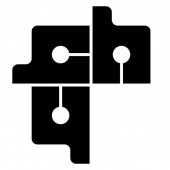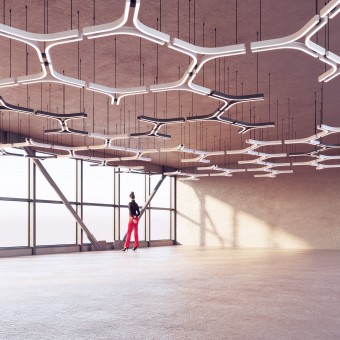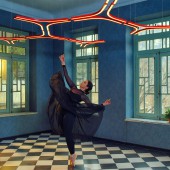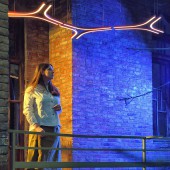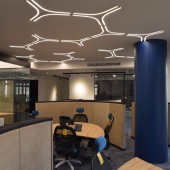DESIGN NAME:
Hexa
PRIMARY FUNCTION:
Light
INSPIRATION:
The form of this design follows a geometric pattern that is inspired by "Girih" and "miniature"; in traditional Iranian architectural decorations.
Girih ( "knot", also written gereh) are decorative Islamic geometric patterns used in architecture and handicraft objects, consisting of angled lines that form an interlaced strapwork pattern.
UNIQUE PROPERTIES / PROJECT DESCRIPTION:
The goal of Hexa design was to achieve a lamp that provides the lighting of the architectural space in two broad and localized modes, has the ability to expand in the space and improves the quality of the space in terms of aesthetics. A Hexa is one third of a full hexagon. This division increases the ability of Hexa in the variety of composition and expansion.
OPERATION / FLOW / INTERACTION:
The coexistence of modules produces a light and geometric network that increases the charisma of the architectural space. This light grid maintains its character independent of the space while providing ambient lighting and creates a decorative effect for the interior designer.
The hexagonal pattern and the geometric expansion system of this scheme provide the designer with the possibility of controlling the direction of expansion and the density of the composition. Also, due to the linear shape of each module, empty spaces have been created between the lights, which will make the lighting network transparent, so the architect or interior designer will not lose the ceiling cover when using this light.
The magnetic connection of the modules makes it easy to "assemble", "disassemble",
"move and replace" and finally, the user can easily control the light network.
PROJECT DURATION AND LOCATION:
This project designed in 2022 in Tehran, Iran.
FITS BEST INTO CATEGORY:
Lighting Products and Fixtures Design
|
PRODUCTION / REALIZATION TECHNOLOGY:
Each module is made of an extruded aluminum profile in a U shape, which is rolled at an angle of 120 degrees, and the LED is placed inside, and the opening of the U is closed with a Plexiglas sheet (as a diffuser). At specific points of each module, pieces of magnets are installed that enable connecting the modules to the fixture (an iron cube that houses the electric wires and is connected to the ceiling structure). After connecting, the electric wires enter each module from inside the fixture, and the electric current reaches the internal lamp. Hexa has the ability to be installed and connected in three modes: surface, built-in and hanging due to the main fixture.
SPECIFICATIONS / TECHNICAL PROPERTIES:
Length of each module: 770 mm
height of profile: 40 mm
width of profile: 20 mm
TAGS:
Geometry, Persian Miniature, Muqarnas, Texture, Wide lighting,Geometric expansion, Dynamics and movement, Simple connections
RESEARCH ABSTRACT:
The goal of Hexa design was to achieve a lamp that provides the lighting of the architectural space in two broad and localized modes, has the ability to expand in the space and improves the quality of the space in terms of aesthetics. A hexa is one third of a full hexagon. This division increases the ability of hexa in the variety of composition and expansion.
The form of this work follows a geometric pattern that is inspired by "knotting" and "miniature"; in traditional Iranian architectural decorations.
To achieve this form, all kinds of geometric shapes such as regular, irregular, odd and even polygons were tested, and in this process "hexagon" was chosen as the primary model because:
Due to the type of internal angles, the shapes with odd sides were oriented in geometric expansion and had less compatibility with general architectural plans, so their use in internal architecture required more and more complex control.
- The hexagonal pattern, when expanded, creates a far more "eye-catching" context than the quadrilateral and "simpler" than the higher degrees of the polygons.
In the next step, the hexagonal pattern was divided into smaller parts, and at the end, a line segment with a curve corresponding to the internal angle of the hexagon was selected as the main module of the design. In fact, a hexa is one third of a full hexagon. This division increases the ability of hexa in the variety of composition and expansion.
Each module is made of an extruded aluminum profile in a U shape, which is rolled at an angle of 120 degrees, and the LED is placed inside, and the opening of the U is closed with a Plexiglas sheet (as a diffuser). At specific points of each module, pieces of magnets are installed that enable connecting the modules to the fixture (an iron cube that houses the electric wires and is connected to the ceiling structure). After connecting, the electric wires enter each module from inside the fixture, and the electric current reaches the internal lamp. Hexa has the ability to be installed and connected in three modes: surface, built-in and hanging due to the main fixture.
The coexistence of modules produces a light and geometric network that increases the charisma of the architectural space. This light grid maintains its character independent of the space while providing ambient lighting and creates a decorative effect for the interior designer.
The hexagonal pattern and the geometric expansion system of this scheme provide the designer with the possibility of controlling the direction of expansion and the density of the composition. Also, due to the linear shape of each module, empty spaces have been created between the lights, which will make the lighting network transparent, so the architect or interior designer will not lose the ceiling cover when using this light.
The magnetic connection of the modules makes it easy to "assemble", "disassemble", "move and replace" and finally, the user can easily control the light network.
CHALLENGE:
It was important to choose the appropriate geometric shape as the initial model. Odd polygons do not extend in a straight line, but even polygons do. In the end, a hexagon was chosen because it formed a more complex structure than a quadrilateral and simpler than a higher degree pair of polygons.
ADDED DATE:
2023-02-09 10:35:06
TEAM MEMBERS (1) :
IMAGE CREDITS:
saeed MirTahmasb
maryam saeedpoor
|
